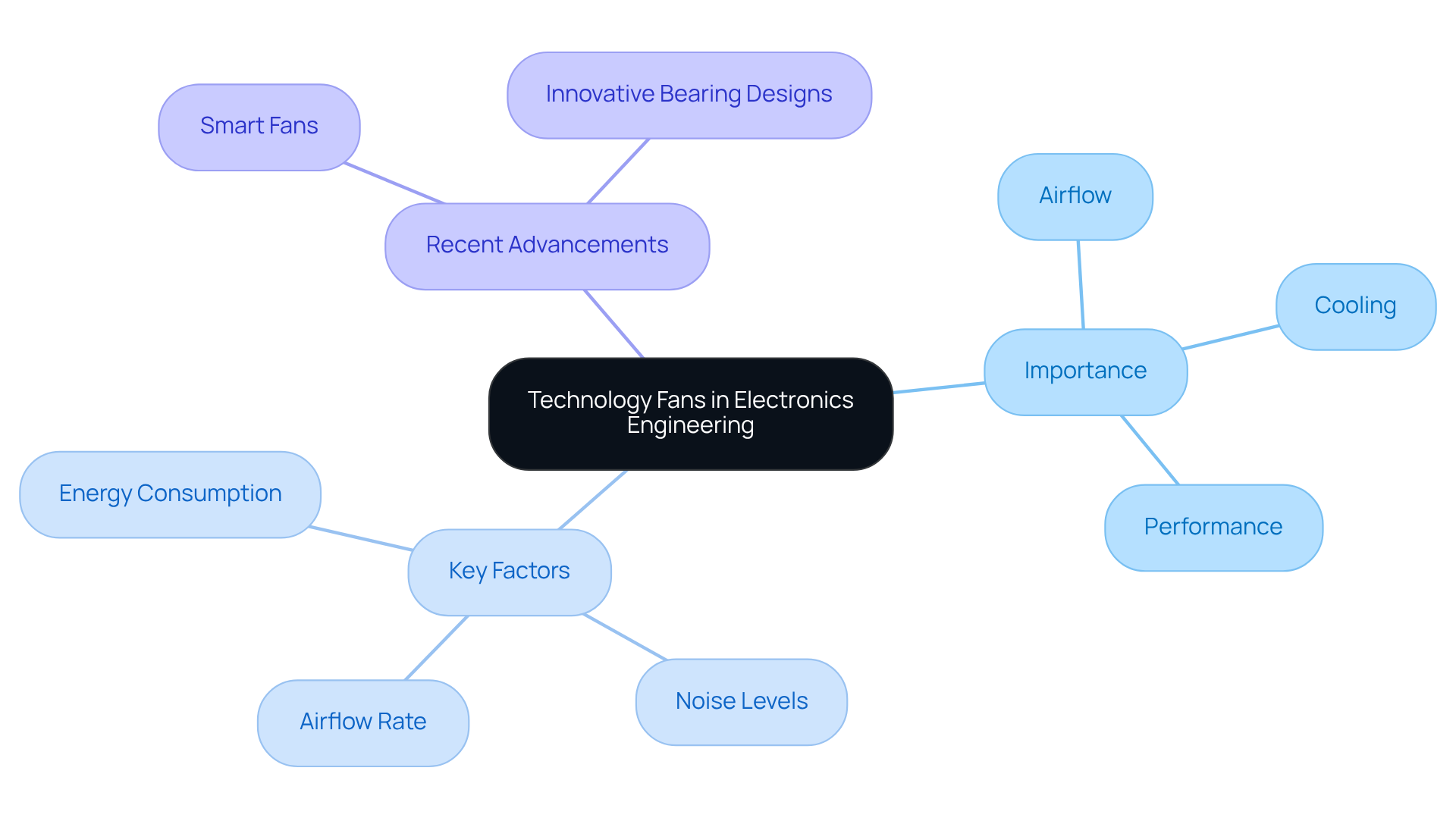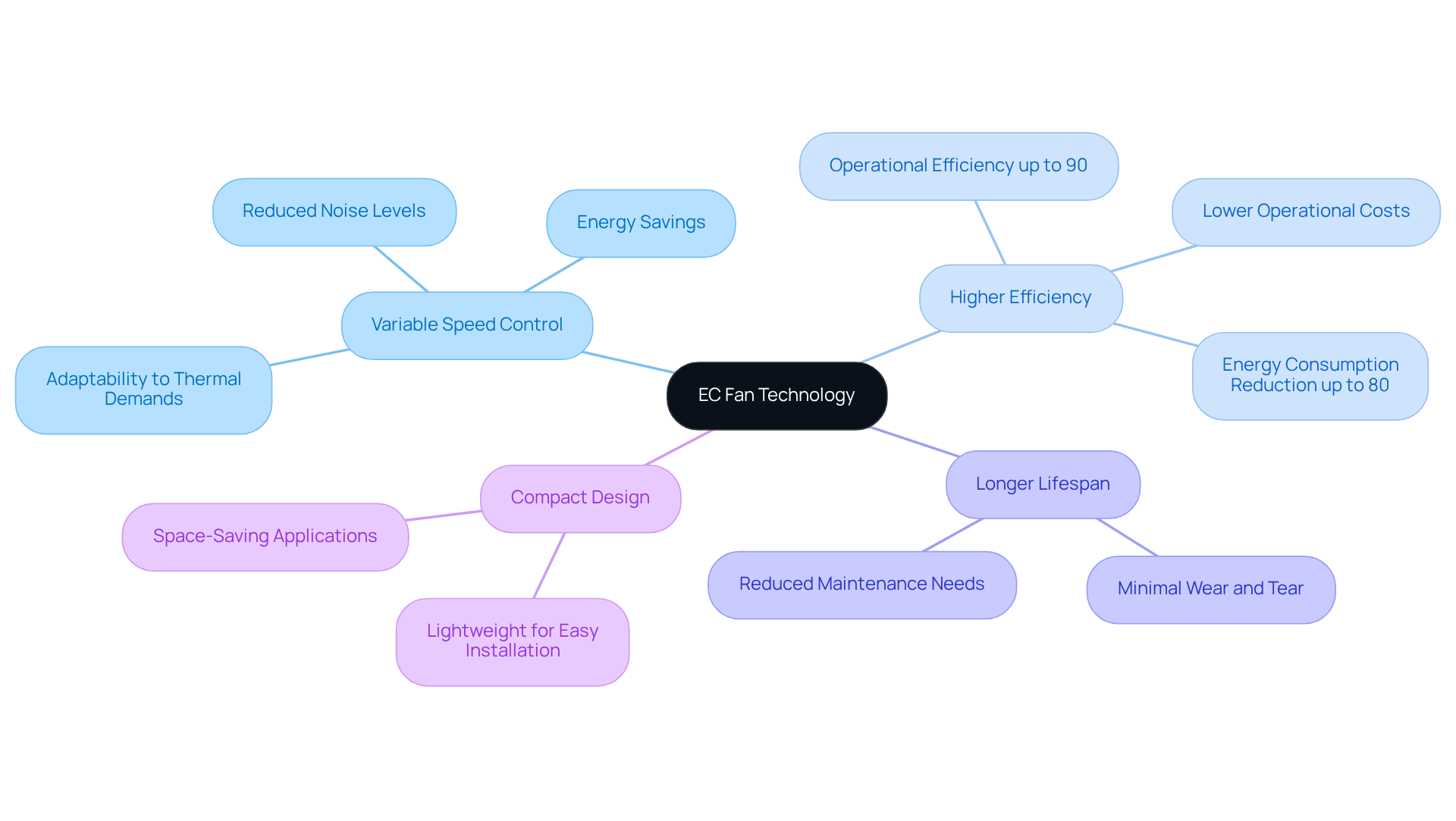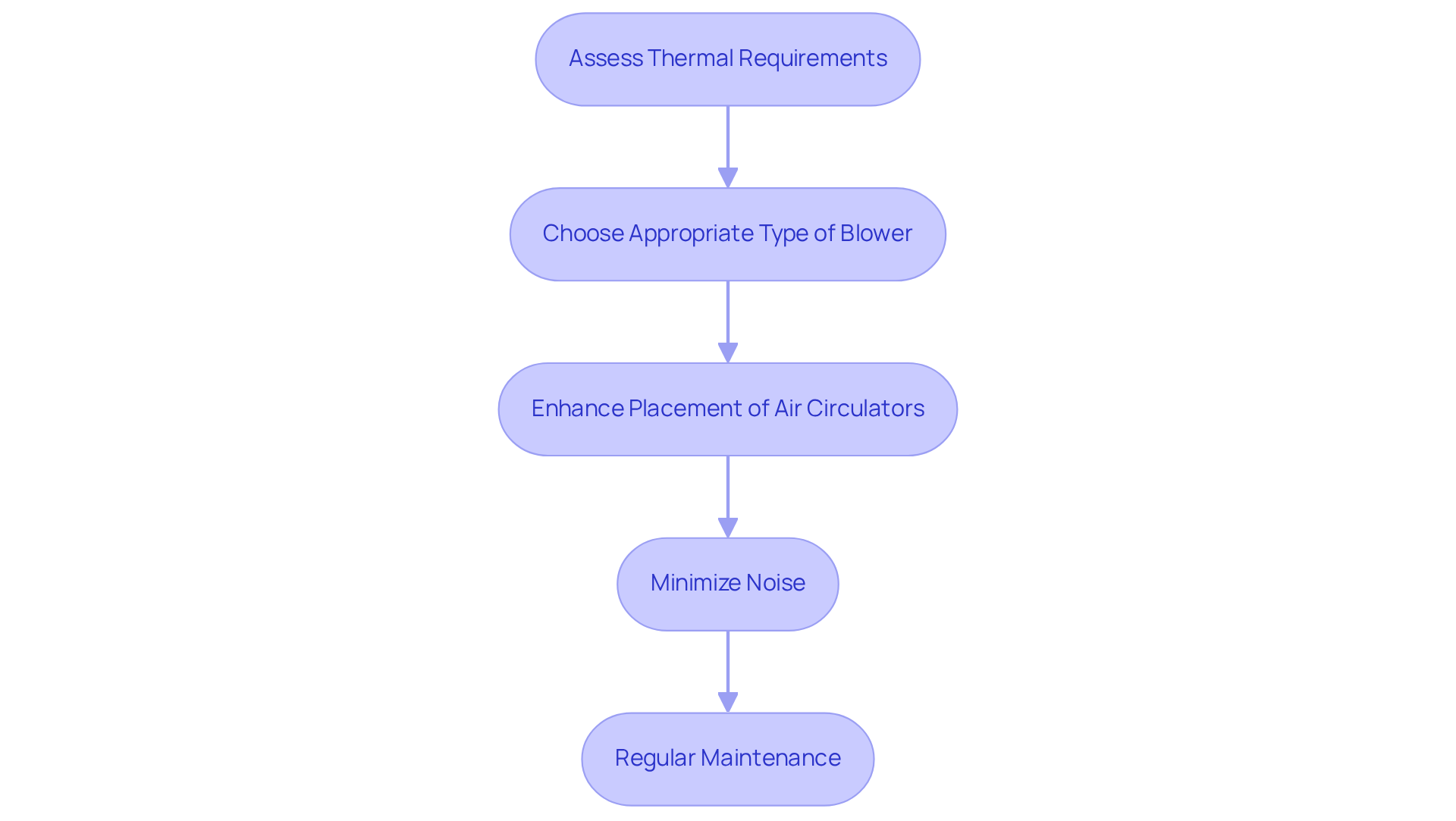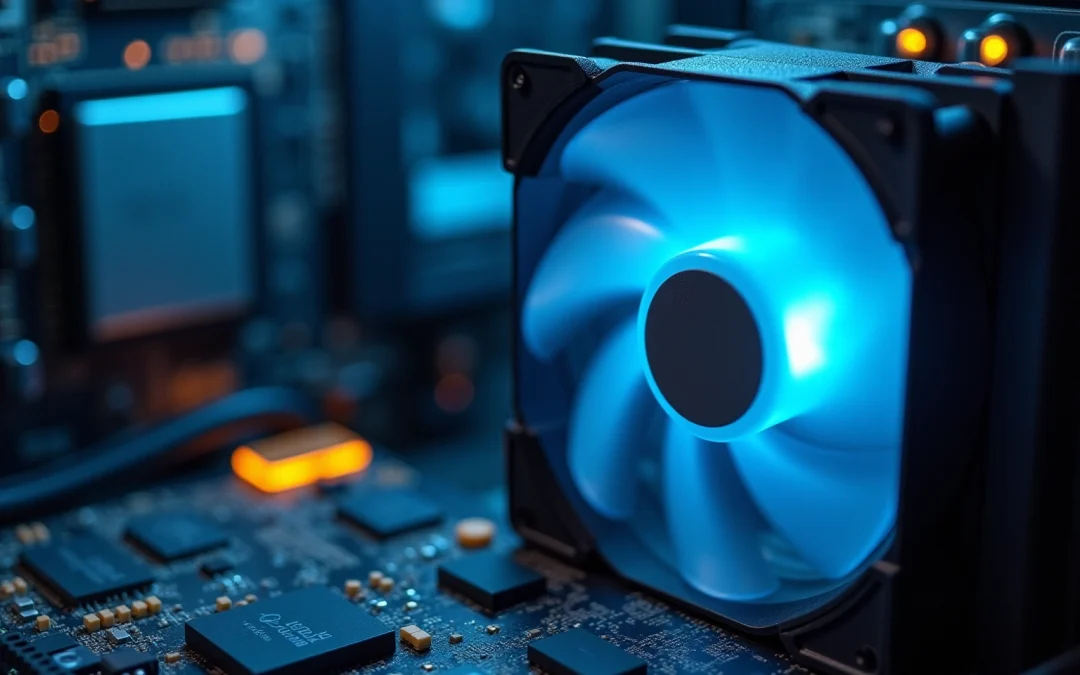Overview
The article underscores the crucial role of technology fans in electronics engineering, particularly in maintaining optimal operating temperatures and preventing thermal throttling of components.
Engineers face the challenge of assessing thermal requirements, which necessitates a thorough understanding of various fan types.
By selecting the appropriate fans and implementing best practices for their placement and maintenance, engineers can significantly enhance system reliability and performance.
This comprehensive approach not only addresses the immediate concerns of thermal management but also fosters long-term operational efficiency.
Introduction
In the intricate world of electronics engineering, the significance of technology fans often goes unnoticed; yet, their role in maintaining optimal operating temperatures is crucial. These devices not only prevent thermal throttling but also enhance the reliability and performance of electronic systems. With the emergence of advancements in fan technology, such as Electronically Commutated (EC) fans, engineers encounter the challenge of integrating these solutions effectively. They must balance efficiency, noise levels, and energy consumption. How can engineers leverage these innovations to optimize cooling and ensure the longevity of their systems?
Define Technology Fans and Their Importance in Electronics Engineering
Technology enthusiasts play a critical role in promoting airflow and cooling within electronic setups, which is essential for maintaining optimal operating temperatures for components such as processors and power supplies. By ensuring adequate airflow, these devices effectively prevent thermal throttling, a condition that can degrade performance or even lead to component failure. Recognizing the significance of technology fans is vital in the field of electronics engineering, as their contributions directly influence the reliability and performance of the entire system. Engineers must carefully evaluate key factors such as airflow rate, noise levels, and energy consumption when selecting blowers for their designs, ensuring alignment with the specific temperature control requirements of their applications.
Recent advancements in temperature regulation technology, including the integration of smart fans and innovative bearing designs, have significantly enhanced the performance and efficiency of these devices. Intelligent systems can automatically adjust their speed in response to temperature changes, optimizing energy usage while ensuring effective temperature management. This evolution in technology not only elevates the user experience for technology fans but also prolongs the lifespan of electronic components, highlighting the necessity of in today’s technology-driven environment.

Explore EC Fan Technology: Features and Benefits
Electronically Commutated (EC) units represent a significant advancement in technology, effectively merging the benefits of AC and DC devices. These devices utilize a brushless motor paired with a built-in electronic controller, which allows for precise speed regulation and improved energy efficiency. The key features of EC fans include:
- Variable Speed Control: EC fans adjust their speed according to thermal demands, resulting in decreased energy consumption and lower noise levels.
- Higher Efficiency: Compared to traditional AC units, which typically operate at efficiencies between 60% and 70%, EC models can achieve operational efficiencies of up to 90%. This translates to reduced operational costs and .
- Longer Lifespan: The absence of brushes in the motor design minimizes wear and tear, contributing to a longer operational life.
- Compact and Lightweight Design: EC motors are designed to be smaller and lighter, making them particularly suitable for applications with space constraints, such as HVAC units in modern urban buildings.
The benefits of EC fan technology make it an ideal choice for applications requiring reliable and efficient temperature regulation solutions, especially in environments where energy savings are paramount. For instance, in data centers, the implementation of EC units has been shown to significantly reduce energy consumption, as evidenced by the Cyxtera Data Center’s focus on energy-efficient cooling and cost reduction. Engineers have noted that the integration of EC devices not only enhances performance but also leads to substantial cost savings over time, underscoring their critical role in contemporary electronic applications.

Implement Technology Fans in Electronic Systems: Best Practices and Considerations
When implementing technology fans in electronic systems, engineers must follow to ensure optimal performance and reliability.
- Assess Thermal Requirements: Begin by conducting a thorough analysis of heat generation and airflow needs. This assessment is crucial for determining the temperature regulation requirements of your setup, guiding the choice and positioning of fans to ensure their capacity aligns with the thermal load.
- Choose the Appropriate Type of Blower: Select from AC, DC, or EC units based on your setup’s power source, performance requirements, and control features. Notably, EC devices are recognized for their energy efficiency, significantly reducing power usage—an essential consideration given that climate control mechanisms account for approximately 38% of overall energy consumption in data centers. Furthermore, thermal energy can represent 50-100% of IT power in large-scale setups, underscoring the necessity for efficient thermal management.
- Enhance Placement of Air Circulators: Strategically arrange air circulators to establish effective airflow patterns, ensuring that cool air enters while warm air exits the setup efficiently. In larger systems, deploying multiple units can enhance airflow and mitigate hotspots. Improper placement can lead to inadequate cooling and elevated operational temperatures, which must be avoided.
- Minimize Noise: Opt for ventilators with low noise ratings and consider integrating sound-dampening materials into your design. This is particularly vital in environments such as hospitals or recording studios, where maintaining low noise levels is imperative.
- Regular Maintenance: Schedule routine checks and maintenance for fans to ensure they operate efficiently and prevent dust buildup, which can impede performance. Regular cleaning or changing of dust filters is essential to sustain optimal airflow and avoid pressure loss, which can diminish effectiveness.
By following these best practices, technology fans can significantly enhance the reliability and effectiveness of their electronic systems, ensuring optimal thermal management and performance. Research indicates that effective thermal control can lead to substantial improvements in power supply performance, with energy usage reductions of up to 7.2% achievable through optimized temperature regulation methods. Additionally, thermoelectric coolers (TECs) can save approximately 27% cooling power on average in data centers, highlighting their efficiency advantages. As Andrew Bryars emphasized, after selecting a fan, a final check should be performed by measuring component temperatures in the final configuration to ensure they remain within specified limits.

Conclusion
Technology fans are indispensable in the realm of electronics engineering, serving a pivotal role in ensuring optimal thermal management and system reliability. Their ability to maintain appropriate operating temperatures for critical components not only enhances performance but also extends the lifespan of electronic devices. Understanding the importance of technology fans is crucial for engineers aiming to design efficient and robust electronic systems.
The article delves into several key aspects surrounding technology fans, including the evolution of Electronically Commutated (EC) fan technology, which offers significant advantages such as variable speed control, higher efficiency, and a longer operational lifespan. Best practices for implementing these fans in electronic systems emphasize the need for thorough thermal assessments, appropriate blower selection, strategic placement, noise minimization, and regular maintenance. Each of these considerations is vital for achieving effective cooling and ensuring the overall performance of electronic systems.
In conclusion, the integration of technology fans in electronic engineering is not merely a choice but a necessity for optimizing system performance and energy efficiency. As the demand for advanced cooling solutions continues to rise, engineers are encouraged to adopt these best practices and leverage innovations in fan technology. By doing so, they can contribute to the creation of more reliable, efficient, and sustainable electronic systems, ultimately enhancing the user experience and reducing operational costs in various applications.
Frequently Asked Questions
What is the role of technology fans in electronics engineering?
Technology fans are critical for promoting airflow and cooling within electronic setups, which helps maintain optimal operating temperatures for components like processors and power supplies.
Why is adequate airflow important for electronic devices?
Adequate airflow prevents thermal throttling, which can degrade performance or lead to component failure, thereby influencing the reliability and performance of the entire system.
What factors should engineers consider when selecting fans for electronic designs?
Engineers should evaluate airflow rate, noise levels, and energy consumption to ensure that the fans align with the specific temperature control requirements of their applications.
How have recent advancements improved technology fans?
Recent advancements include the integration of smart fans and innovative bearing designs that enhance performance and efficiency, allowing fans to automatically adjust their speed in response to temperature changes.
What benefits do intelligent fan systems provide?
Intelligent fan systems optimize energy usage while ensuring effective temperature management, which improves the user experience and prolongs the lifespan of electronic components.
Why is robust cooling essential in today’s technology-driven environment?
Robust cooling solutions are necessary to manage heat effectively, ensuring the reliability and longevity of electronic devices in a rapidly evolving technological landscape.

